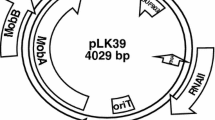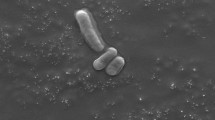Abstract
Extrachromosomal elements were found in a strain ofX. dendrorhous, and were characterized as linear DNA forming two well defined groups, pPh1 with 3 high-copy-number molecules, pPh11 (6.9 kb), pPh12 (5.7), pPh13 (4.7), and pPh2 with 2 low-copy-number molecules, pPh21 (3.6 kb), pPh22 (3.0). A 4077 bp fragment from pPh13 was cloned in pUC18 (pDK1) and sequenced (accession no. AJ 278 424). Seven putative ORF and some possible regulator sequences were defined.
Similar content being viewed by others
References
Adrio J., Veiga M., Casqueiro J., López M., Fernández C.: Isolation ofPhaffia rhodozyma auxotrophic mutants by enrichment methods.J. Gen. Appl. Microbiol.39, 303–312 (1993).
Adrio J.L., Veiga M.: Transformation of the astaxanthin-producing yeastPhaffia rhodozyma.Biotechnol. Tech.9, 509–512 (1995).
An G.H., Schuman D.B., Johnson E.A.: Isolation ofPhaffia rhodozyma mutants with increased astaxanthin content.Appl. Environ. Microbiol.55, 116–124 (1989).
Castillo A.N., Cifuentes V.G.: RNA de doble hebra asociado a particulas tipo virus enPhaffia rhodozyma.Ann. Microbiol.1, 63–66 (1993).
Castillo A.N., Cifuentes V.G.: Presence of double-stranded RNA and virus-like particles inPhaffia rhodozyma.Curr. Genet.26, 364–368 (1994).
Carusi E.A.: Evidence for blocked 5′-termini in human adenovirus DNA.Virology76, 380–394 (1977).
Cavalier-Smith T.: Palindromic base sequence and replication of eukaryote chromosome ends.Nature250, 467–470 (1974).
Ducrey Santopietro L.M., Spencer J.F.T., Spencer D.M., Siñeriz F.: Formation of protoplasts fromPhaffia rhodozyma.Biotechnol. Tech.9, 339–345 (1995).
Ducrey Santopietro L.M., Spencer J.F.T., Siñeriz F.: Fed-batch and continuous cultivation ofPhaffia rhodozyma (Xanthophyllomyces dendrorhous).Folia Microbiol.43, 169–172 (1998).
Ducrey Santopietro L.M., Spencer J.F.T., Spencer D.F., Siñeriz F.: Effect of oxidative stress on the production of carotenoid pigments byPhaffia rhodozyma (Xanthophyllomyces dendrorhous).Folia Microbiol.43, 173–176 (1998).
Fukuhara H.: Linear DNA plasmids of yeasts.FEMS Microbiol. Lett.131, 1–9 (1995).
Golubev W.I.: Perfect state ofRhodomyces dendrorhous (Phaffia rhodozyma).Yeast11, 101–110 (1995).
Gunge N., Sakaguchi K.: Isolation and characterization of linear deoxyribonucleic acid plasmid fromKluyveromyces lactis and the plasmid-associated killer character.J. Bacteriol..145, 383–390 (1981).
Hishinuma F., Nakamura K., Hirai K., Nishizawa R., Gunge N., Maeda T.: Cloning and nucleotide sequences of the linear DNA killer plasmids from yeast.Nucl. Acids Res.12, 7581–7597 (1984).
Johnson E.A., Konklin D.E., Lewis M.J.: The yeastPhaffia rhodozyma a as dietary pigment sourse for salmonids and crustaceans.J. Fish. Res. Board Can.34, 2417–2421 (1977).
Katayose Y., Kajiwara S., Shishido K.: The basidiomyceteLentinus edodes linear mitochondrial DNA plasmid contains a segment exhibiting a high autonomously replicating sequence activity inSaccharomyces cerevisiae.Nucl. Acids Res.18, 1395–1400 (1990).
Lim B.P., Nagao A., Terao J., Tanaka K., Suzuki T., Takama K.: Antioxidant activity of xanthophylls on peroxyl radical-mediated phospholipid peroxidation.Biochim. Biophys. Acta1126, 178–184 (1992).
Maniatis T., Fritsch E.F., Sambrook J. (Eds):Molecular Cloning: a Laboratory Manual. Cold Spring Harbor Laboratory, Cold Spring Harbor, New York 1982.
McCracken D.A., Martin V.J., Stark M.J.R., Bolen P.L.: The linear-plasmid-encoded toxin produced by the yeastPichia acaciae: characterization and comparison with the toxin ofKluyveromyces lactis.Microbiology140, 425–431 (1994).
Miller M.W., Yoneyama M., Soneda M.:Phaffia, a new yeast genus in theDeuteromycotina (Blastomycetes).Internat. J. Syst. Bacteriol.26, 286–291 (1976).
Nakajima M., Sheikh Q.I., Yamaoka K., Yui Y., Kajiwara S., Shishido K.: Bending of DNA segments withSaccharomyces cerevisiae autonomously replicating sequence activity, isolated from basidiomycete mitochondrial linear plasmids.Mol. Gen. Genet.237, 1–9 (1981).
Oppenhiem A.: Separation of closed circular DNA from linear DNA by electrophoresis in two dimensional agarose gels.Nucl. Acids Res.9, 6805–6812 (1981).
Pfeiffer I., Kucsera J., Varga J., Párducz A., Ferenczy L.: Variability and inheritance of double-stranded RNA viruses inPhaffia rhodozyma.Curr. Genet.30, 294–297 (1996).
Powell W.A., Kistler H.C.:In vivo rearrangement of foreign DNA byFusarium oxysporum produces linear self-replicating plasmids.J. Bacteriol.172, 3163–3171 (1990).
Roy N., Runge K.W.: The ZDS1 and ZDS2 proteins require the Sir3p component of yeast silent chromatin to enhance the stability of short linear centromeric plasmids.Chromosoma108, 146–161 (1999).
Rubinstein L., Altamirano A., Ducrey Santopietro L.M., Baigorí M., Castellanos de Figueroa L.: Transformation ofPhaffia rhodozyma by electroporation.Biotechnol. Tech.10, 929–932 (1997).
Rubinstein L., Altamirano A., Ducrey Santopietro L.M., Baigorí M., De Figueroa L.I.C.: Isolation and characterization ofPhaffia rhodozyma mutants.Folia Microbiol.43, 626–630 (1998).
Slaninová I., Kucsera J., Svoboda A.: Cytoskeleton and mitochondrial topology inPhaffia rhodozyma (Xanthophyllomyces dendrorhous).Folia Microbiol.45, 89 (2000).
Sor F., Wesolowski M., Fukuhara H.: Inverted terminal repetitions of the two linear DNA associated with the killer character of the yeastKluyveromyces lactis.Nucl. Acids Res.11, 5037–5044 (1983).
Wery J., Gutker D., Renniers A.C.H.M., Verdoes J.C., van Ooyen A.J.J.: High copy number integration into the ribosomal DNA of the yeastPhaffia rhodozyma.Gene184, 89–97 (1997).
Wesolowski M., Fukuhara H.: Linear mitochondrial deoxyribonucleic acid from the yeastHansenula mrakii.Mol. Cell. Biol.1, 387–393 (1981).
Yan P.Y., Eulenstein O., Vingron M., Bork P.: Towards detection of orthologues in sequence databases.Bioinformatics14, 285–289 (1998).
Yui Y., Katayose Y., Shishido K.: Two linear plasmid-like DNA elements simultaneously maintained inPleurotus ostreatus.Biochim. Biophys. Acta951, 53–60 (1988).
Author information
Authors and Affiliations
Rights and permissions
About this article
Cite this article
Ducrey Santopietro, L.M., Kula, M.R. Cloning and nucleotide sequence of a linear DNA plasmid fromXanthophyllomyces dendrorhous (Phaffia rhodozyma) . Folia Microbiol 46, 277–288 (2001). https://doi.org/10.1007/BF02815614
Received:
Issue Date:
DOI: https://doi.org/10.1007/BF02815614




